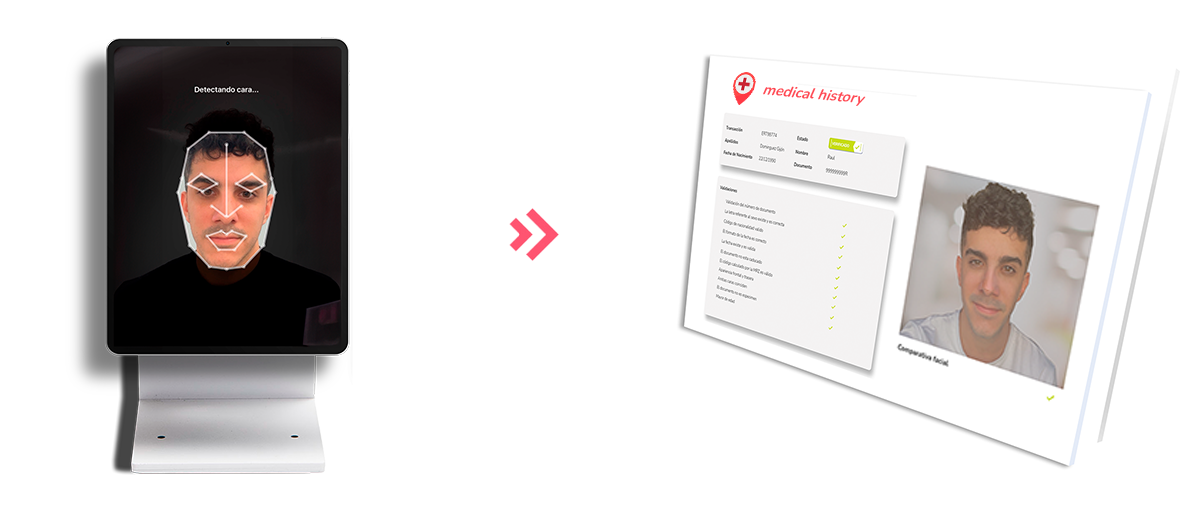The healthcare industry is lagging in terms of digitisation, especially when it comes to the patient digital identity and healthcare staff.
The current digitalisation of healthcare, which includes, for example, a website with a username and password to make medical appointments or consult medical records, is neither sufficient nor secure. It is necessary to go a step further to protect sensitive patient data and improve efficiency in healthcare. The adoption of biometric identification in this sector would allow better user verification, digitise medical records, and improve the quality of patient care.
According to a WHO report, 2.6 million people die each year due to medical mistakes, including patient identification errors, costing healthcare organisations in low- and middle-income countries an estimated $42 billion.
To put an end to these harms, one of the most innovative concepts in this field is the Patient Centric Model. This approach puts the patient at the centre of all medical decisions and processes and can leverage the use of biometrics to transform the healthcare landscape.
But what is the Patient Centric Model?
The Patient Centric Model is based on the idea that healthcare should be about the patient, not the system. It implies customised care, where the patient’s needs and preferences are prioritised. Key to this model is the integration of digital identity and the use of biometrics to ensure an efficient and secure medical experience.
The Patient-Centric Model advocates a holistic approach, considering not only the medical aspects of the patient but also their social, emotional, and psychological contexts. Health technology plays a key role here, providing advanced tools for health monitoring and management, enabling a deeper and more complete understanding of the patient as an individual.

Furthermore, in a patient-centred model, patient participation in the care process is important. Health technology eases this involvement through apps and platforms that allow patients to access their medical records, schedule appointments, communicate with their health insurance and monitor their well-being in real time. This accessibility empowers patients, giving them control over their health and fostering closer collaboration with their doctors.
Biometrics completes the holistic approach of the Patient Centric Model
Biometrics is essential for patient identification, achieving a holistic approach to patient care. This technology streamlines healthcare processes and significantly improves the patient experience.
Biometrics provides an accurate and secure method of identifying patients by unique physical features. This biometric identification eliminates the risk of common errors in medical records management, such as mistaken identity and duplicate patients, ensuring the patient’s digital identity and that each patient receives appropriate care.
But what can it complement?
Biometrics as a complement to ID wristbands or hospital bracelet
When patients are admitted to a hospital, identification wristbands are commonly used to avoid mistakes in identification and treatment administration. Nevertheless, these bracelets can be transferred incorrectly or contain data errors, which can result in significant problems in medical care. In this regard, facial biometrics offers an additional layer of security and accuracy by providing unique, non-transferable identification based on physical characteristics.
Biometrics plays a crucial role in enhancing patient identification from the moment of admission, effectively complementing the use of wristbands. Unlike hospital bracelets, which can be prone to human error or accidental tampering, biometrics ensures accurate authentication, thereby reducing the risk of confusion and fraud. This integration strengthens the hospital’s identification protocol, ensuring that each patient is correctly recognised.
In addition to impacting accuracy, biometrics also optimises operational efficiency within the hospital. By being integrated into the admission process and throughout patient care, this technology enables fast and secure verification of patient identity, simplifying clinical processes.
Biometrics as an ally in matching patients with their medical records
Biometrics plays a key role in integrating the Patient-Centric Model by facilitating accurate and secure identification of patients and ensuring efficient access to their medical records. This advanced technology not only quickly verifies patient identity but also improves coordination and continuity of care.
Integrated from the admission phase through to post-treatment follow-up, biometrics ensures that each patient is correctly linked to their medical records at all times.

In terms of security and privacy, biometrics establishes an additional barrier against unauthorised access to sensitive medical information.
In addition to mitigating the risks of identification errors that could result in unnecessary repeat tests and treatments, biometrics improves the operational efficiency of the healthcare system by eliminating redundancies and minimising costs associated with administrative errors. This strengthens confidence in the healthcare system by demonstrating an ongoing commitment to patient safety and well-being.
Patient touchpoints at which apply biometrics
Biometrics can be applied at various patient touchpoints, improving the experience and efficiency of the medical process:
- Patient registration (Know Your Patient – KYP): accurate verification of patient identity during registration from the beginning of their interaction with the health system or health insurance.
- Patient’s digital identity and access to their private area: through biometric authentication, patients can access their private areas to consult test results, schedule appointments, etc.
- Entry into the test box: biometric identification ensures that the patient entering for a test is the correct one, eliminating identity errors. This is essential to maintain the integrity of clinical data and ensure that each procedure is performed according to each patient’s unique medical history.
- Biometric signature of consents and treatments: the biometric signature ensures that consents and authorisations are legally binding and that the patient has given their approval.
- Collection of analyses and other sensitive tests: biometrics ensures that test results and analyses are delivered to the correct patient while maintaining confidentiality.
- Identification in emergency situations: fast recognition for emergencies. It facilitates immediate medical care by ensuring that healthcare staff can quickly access relevant patient medical information, such as allergies, chronic conditions or previous treatment history.
- Streamlining hospital admission processes: reducing time and administrative errors.
- Health card fraud prevention: elimination of health insurance misuse or unauthorised access to health services.
Biometric touchpoints for healthcare staff
Healthcare professionals can also benefit from biometrics in a number of ways:
- Access control to operating theatres or restricted areas: security in sensitive areas of the hospital to ensure a controlled and secure environment for sensitive medical procedures.
- Shift entry: identity verification at the start of shifts to maintain the integrity of the assignment of responsibilities and tasks among medical and administrative staff.
- Authentication on IT systems: secure access to medical records and other critical systems considered confidential.
Digital patient identity to prevent harm and delays due to medical testing errors
Inaccurate identification of a patient’s digital identity can lead to serious mistakes in the performance and interpretation of medical tests, resulting in incorrect diagnoses and inappropriate treatment. Biometrics helps mitigate these risks by ensuring that every sample and result is correctly associated with the right patient, avoiding unnecessary harm and costly delays in care.
Smart hospitals with biometric technology
The integration of biometrics can greatly benefit the concept of smart hospitals, which use advanced technology to improve patient outcomes and streamline operations. This technology can be used for patient identification, access control, and smart room allocation.
In addition, during health crises, biometrics can be an invaluable tool for monitoring travellers’ health, secure access to vaccination or medication records, and user control in hospitals and medical centres. In this sense, biometrics plays an important role in digital patient identity management, public health, and disease control.
Telemedicine and IoMT
Biometrics plays a vital role in the growth of telemedicine, enabling secure authentication for digital visits. By using biometrics in conjunction with the Internet of Medical Things (IoMT), patient’s health can be effectively monitored and managed remotely, ensuring a better quality of care and data protection.

Voice biometrics in telephone patient care
Voice biometrics simplifies the process of verifying patient identity during telephone calls, eliminating the need to ask for personal details. This improves the patient experience and reduces frustration by reducing friction in telephone interactions.
Furthermore, this type of biometrics allows for personalisation and improved efficiency in user care. Health systems can quickly route the call to the right department or specialist by automatically recognising the patient’s identity at the beginning of the call, reducing waiting times and improving overall service response.
And one of the most important issues is preventing digital patient identity fraud
Facial biometrics can have a significant impact on the healthcare industry by eliminating the possibility of fraud and abuse in the use of health cards or health insurance. Health insurance companies often rely on information provided by the policyholder to verify eligibility, which can lead to abuse.
Biometric identification can verify identity correctly, reducing the possibility of fraud and ensuring that health services are used only by those who are entitled to them.
Reach out if you are looking for a biometric solution that enhances a patient’s digital identity, we can provide you with technology that ensures better and more secure patient-centred healthcare.

I am a curious mind with knowledge of laws, marketing, and business. A words alchemist, deeply in love with neuromarketing and copywriting, who helps Mobbeel to keep growing.

GUIDE
Fully know your patients and drive the growth of your health center
The journey between an organisation and its clients begins with proper verification, ensuring the safety of both parties. This KYC guide is essential for understanding the importance of knowing your users and complying with legal requirements.




